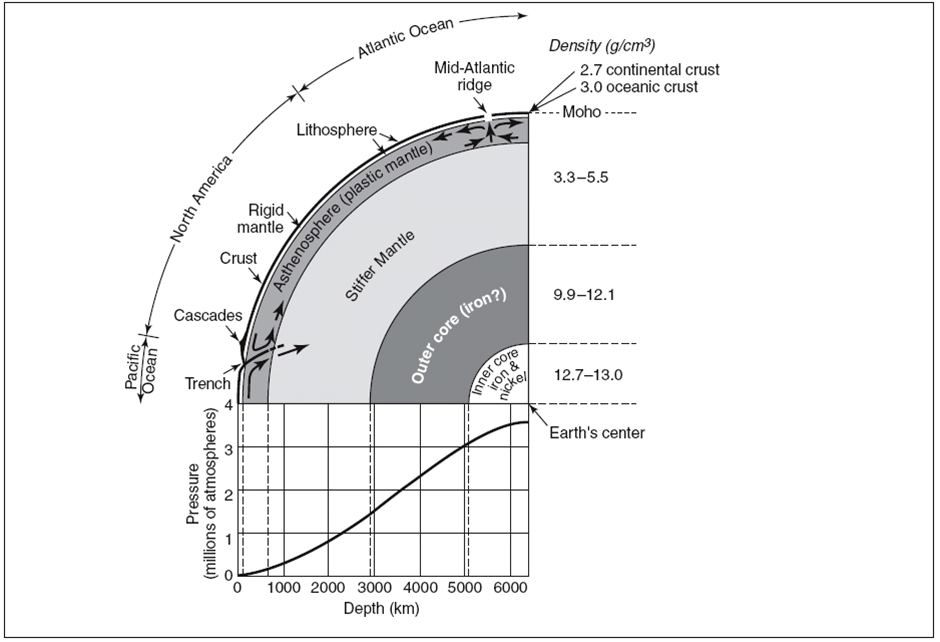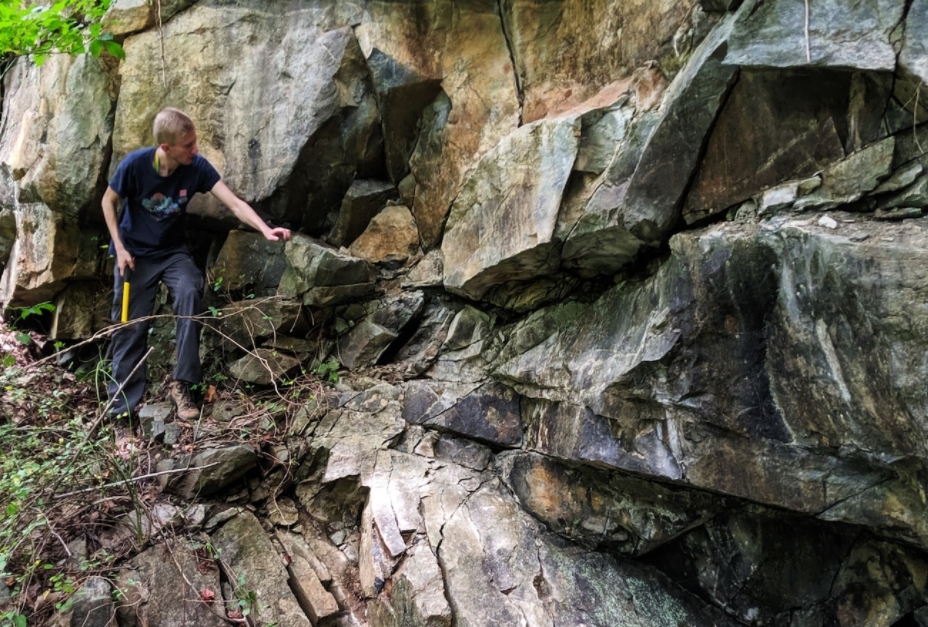35 Studying the Earth’s Interior
Layers of the Earth:
Earth Structure Summary:
| Physical Layers of Earth | ||
|---|---|---|
| Layer | Physical Behavior | Thickness |
| Lithosphere (crust and upper mantle) | rigid, brittle at shallow depths | 5–200 km |
| Asthenosphere | ductile, flows | 100–300 km |
| Upper Mesosphere (upper mantle) | rigid, not brittle, rapid increase in density with depth | 300–400 km |
| Lower Mesosphere (lower mantle) | denser and more rigid than upper mesosphere | 2,300 km |
| Outer Core | liquid | 2,300 km |
| Inner Core | rigid, not brittle | 1,200 km |
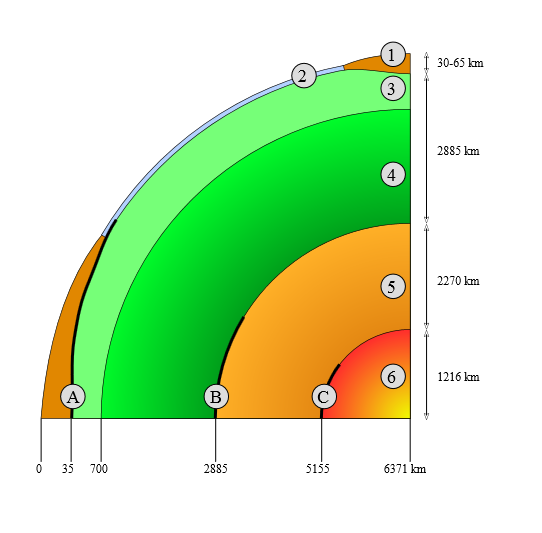 Schematic view of the interior of Earth: 1. continental crust – 2. oceanic crust – 3. upper mantle – 4. lower mantle – 5. outer core – 6. inner core
Schematic view of the interior of Earth: 1. continental crust – 2. oceanic crust – 3. upper mantle – 4. lower mantle – 5. outer core – 6. inner core
A: crust-mantle boundary (Mohorovičić discontinuity, also known as “Moho”)
B: core-mantle boundary (also known as Gutenberg discontinuity)
C: boundary between inner and outer core (also known as Lehmann discontinuity)
Source of the image: https://en.wikipedia.org/wiki/Structure_of_the_Earth#/media/File:Slice_earth.svg
Inferred physical properties of Earth’s interior
Comprehensive Analysis of the Earth Interior structure and Properties (free accessible McGraw Hill resource):
The Earth interior is not accessible to direct observation. Nevertheless, a rather detailed model has been constructed on the basis of measurements made at or above the surface.
Measurements of gravity, the geomagnetic field, surface heat flow, and surface deformation can all be used to put constraints on the Earth model, but the most detailed information about the interior is provided by seismic measurements.
Earth Crust
How does a loaf of bread resemble Earth?
 A loaf of homemade bread could almost resemble Earth. The raised parts of the crust are the continents and the depressed parts are the oceans. The inside is gooier than the brittle exterior, but it’s still solid. How is a loaf of bread not like Earth?
A loaf of homemade bread could almost resemble Earth. The raised parts of the crust are the continents and the depressed parts are the oceans. The inside is gooier than the brittle exterior, but it’s still solid. How is a loaf of bread not like Earth?
Earth’s outer surface is its crust, a cold, thin, brittle outer shell made of rock. The crust is very thin relative to the radius of the planet.
There are two very different types of crust, each with its own distinctive physical and chemical properties, which are summarized in Table 1.
| Crust | Thickness | Density | Composition | Rock Types |
|---|---|---|---|---|
| Oceanic | 5–12 km (3–8 mi) | 3.0 g/cm3 | Mafic | Basalt and gabbro |
| Continental | Avg. 35 km (22 mi) | 2.7 g/cm3 | Felsic | All types |
Oceanic Crust
Oceanic crust is composed of mafic (i.e. low content of silica, dark color) magma that erupts on the seafloor to create basalt lava flows or cools deeper down to create the intrusive igneous rock gabbro (Figure 1).
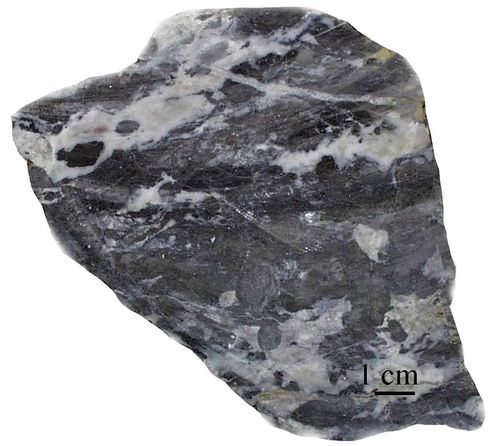
Figure 1. Gabbro from ocean crust
The oceanic crust is relatively thin and lies above the mantle. The cross section of oceanic crust in Figure 2 shows the layers that grade from oceanic sediments at the top to extrusive pillow basalt lava, to the sheeted dikes that feed lava to the surface, to deeper intrusive gabbro, and finally to the mantle.

Ophiolites: a specific term for the oceanic crust rock complex (as in Fig 2 above).
Ophiolites were found in Italian Alps, Oman and other places because during the plate tectonics cycle these rocks were uplifted and formed mountains.
Below is an illustration of ophiolites formation:
Geology of Oman: how can we see oceanic crust?
We do not need to go to Oman to see upper mantle samples? No, they are right in our backyard!
But the scale is missing!
Continental Crust
Continental crust is made up of many different types of igneous, metamorphic, and sedimentary rocks. The average composition is granite, felsic rock, which is much less dense than the mafic rocks of the oceanic crust (Figure 3).
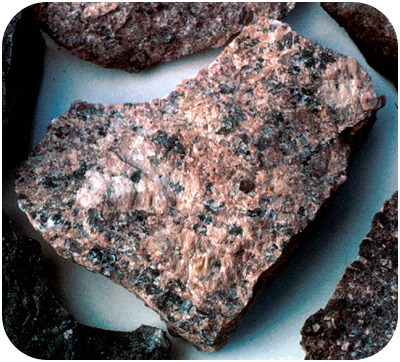
Figure 3. This granite from Missouri is more than 1 billion years old.
So, what is the mystery of the continental crust origin?
Summary
- Oceanic crust is thinner and denser than continental crust.
- Oceanic crust is mafic, continental crust is felsic.
- Continental crust was produced from the oceanic crust by the process of partial melting
- Crust is very thin relative to Earth’s radius.
Lithosphere
The lithosphere is composed of both the crust and the portion of the upper mantle. The lithosphere is the outermost mechanical layer, which behaves as a brittle, rigid solid.
The lithosphere is about 100 kilometers thick.
The definition of the lithosphere is based on how Earth materials behave, so it includes the crust and the uppermost mantle, which are both brittle.
Since it is rigid and brittle, when stresses act on the lithosphere, it breaks. This is what we experience as an earthquake. Although we sometimes refer to Earth’s plates as being plates of crust, the plates are actually made of lithosphere.
Asthenosphere and Mantle
The asthenosphere is an upper mantle material that is so hot that it behaves plastically (i.e. ductile) and can flow.
The lithosphere rides on the asthenosphere.
Scientists know that the mantle is extremely hot because of the heat flowing outward from it and because of its physical properties.
What is a diamond delivery system?
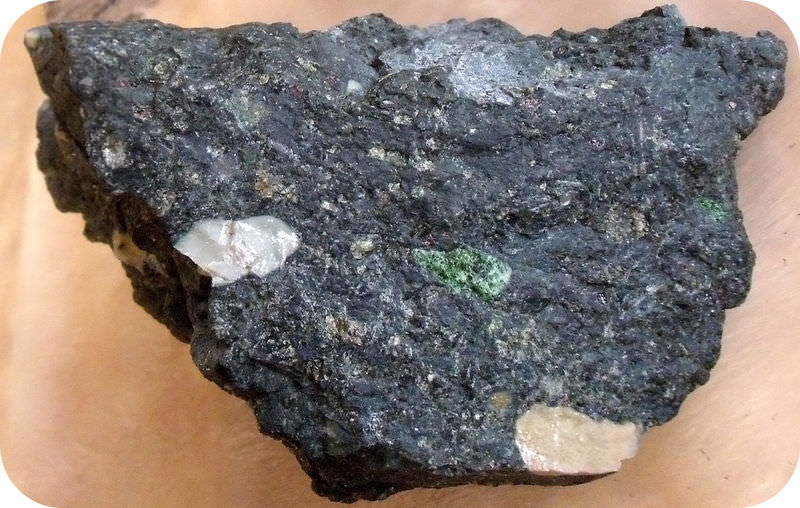 Some events happened when Earth was younger and hotter that do not happen any more. Kimberlite pipes shot up from deep in the mantle. These pipes are the most important source of diamonds, which form at very high pressure. Most kimberlites surfaced long ago.
Some events happened when Earth was younger and hotter that do not happen any more. Kimberlite pipes shot up from deep in the mantle. These pipes are the most important source of diamonds, which form at very high pressure. Most kimberlites surfaced long ago.
The two most important things about the mantle are as follows:
- It is made of semi-solid rock.
- It is hot.
Scientists know that the mantle is made of semi-solid rock based on evidence from seismic waves, heat flow, and meteorites.
The properties fit the ultramafic rock peridotite, which is made of the iron- and magnesium-rich silicate minerals (Figure 1). Peridotite is rarely found at Earth’s surface.
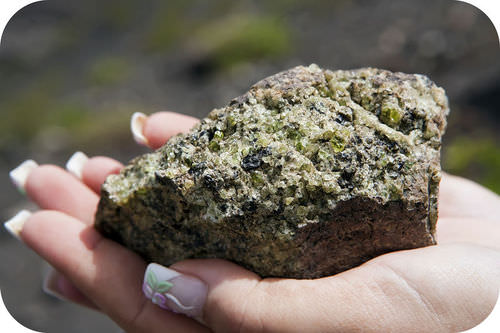
Figure 1. Peridotite is formed of crystals of olivine (green) and pyroxene (black).
Heat Flow
Scientists know that the mantle is extremely hot because of the heat flowing outward from it and because of its physical properties.
Heat flows in two different ways within the Earth:
- Conduction: Heat is transferred through rapid collisions of atoms, which can only happen if the material is solid. Heat flows from warmer to cooler places until all are the same temperature. The mantle is hot mostly because of heat conducted from the core.
- Convection: If a material is able to move, even if it moves very slowly, convection currents can form.
Convection in the mantle is the same as convection in a pot of water on a stove. Convection currents within Earth’s mantle form as material near the core heats up. As the core heats the bottom layer of mantle material, particles move more rapidly, decreasing its density and causing it to rise. The rising material begins the convection current. When the warm material reaches the surface, it spreads horizontally. The material cools because it is no longer near the core. It eventually becomes cool and dense enough to sink back down into the mantle. At the bottom of the mantle, the material travels horizontally and is heated by the core. It reaches the location where warm mantle material rises, and the mantle convection cell is complete (Figure 2).
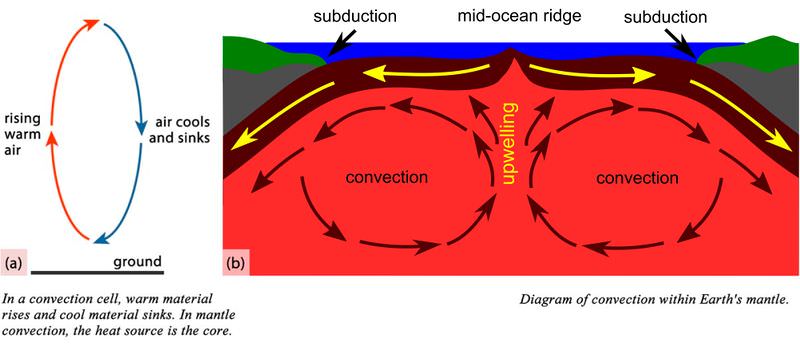
Summary
- The lithosphere is the brittle crust and uppermost mantle.
- The asthenosphere flows (ductile).
- The lithosphere rests on the asthenosphere.
- Asthenosphere and mantle experience convection that drives plate tectonics
Summary of the Earth Interior structure:
Now try to answer questions:
- What does he mean by the mechanical properties of a layer?
- In the compositional model: What is the outermost layer? What are the two types of this layer and what are their main features?
- What is the next layer down? What are its main features?
- What is the deepest layer? Why is this the densest layer?
- What is the composition of this layer?
- What is the lithosphere?
- What are the mechanical properties of the material below the lithosphere and what is the layer called?
- What is the composition and mechanical property of the mesosphere relative to the asthenosphere?
How do we know about the Earth inner structure?
Scientists know that the outer core is liquid and the inner core is solid because:
- S-waves (see explanation below in the sub-chapter on Seismic Waves) do not go through the outer core.
- The strong magnetic field is caused by convection in the liquid outer core. Convection currents in the outer core are due to heat from the even hotter inner core. The heat that keeps the outer core from solidifying is produced by the breakdown of radioactive elements in the inner core.
Scientists know that the inner core is metal because the density of Earth’s surface layers (3.3 g/cm3 and 2.65 g/cm3) is much less than the overall density of the planet (5.52 g/cm3), as calculated from the planet’s rotation.
If the surface layers are less dense than average, then the interior must be denser than average.
| Bibliographic Entry | Result
(w/surrounding text) |
Standardized
Result |
|---|---|---|
| Neff, Robert F. & Zitewitz, Paul W. Physics, Principles and Problems. New York: Glencoe, 1995: 159. | “Mass of the Earth 5.979 × 1024 kg
Radius of the Earth 6.3713 × 103 km” |
5.519 g/cm3 |
| Compton’s Interactive Encyclopedia. Compton’s, 1995. | “They divide the mass of the Earth by the volume, which gives the average density of the material in the earth as 3.2 ounces per cubic inch (5.5 g/cm3).” | 5.5 g/cm3 |
| Orbits Voyage Through The Solar System. Phoenix, AZ: Software Marketing, 1989. | “Mean Density: (water = 1) 5.52.” | 5.52 g/cm3 |
| Morse, Joseph Laffan. Funk & Wagnalls Standard Reference Encyclopedia. New York: Standard Reference Works, 1967: 2934. | “The average density of the planet [Earth] is 5.52” | 5.52 g/cm3 |
| Hamilton, Calvin J. Earth Introduction. Views of the Solar System. | “Mean density (g/cm3) 5.515.” | 5.515 g/cm3 |
Source: https://hypertextbook.com/facts/2000/KatherineMalfucci.shtml
Calculations indicate that the core is about 85% iron metal with nickel metal making up much of the remaining 15%.
Metallic meteorites are thought to be representative of the core.
The 85% iron/15% nickel calculation is also seen in metallic meteorites, see photo below.
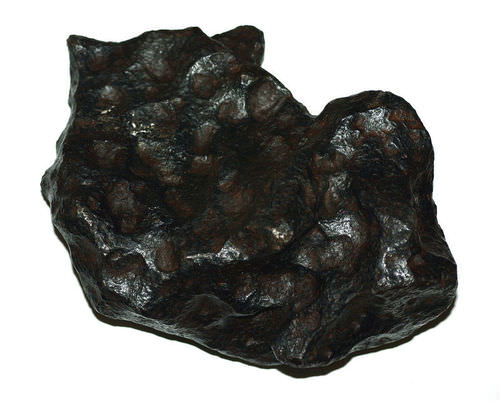
If Earth’s core were not metal, the planet would not have a magnetic field. Metals such as iron are magnetic, but rock, which makes up the mantle and crust, is not.
Below are more detailed information on magnetic field and seismic waves.
Earth’s Magnetic Field Originates in the Core
The liquid outer core is the source of the earth’s magnetic field, as a result of its metallic nature, which means it contains electrons not attached to particular nuclei. Heat is transferred upward to the mantle from the inner core via convective cells, in which the liquid in the outer core flows in looping patterns. The combination of the loose electrons and looping convective flow with the rotation of the earth results in a geodynamo that produces a magnetic field.
Because the magnetic field is generated by a dynamically convecting and rotating sphere of liquid, it is unstable. Every now and then, after several hundred thousand to several million years, the earth’s magnetic field becomes unstable to the point that it temporarily shuts down. When it restarts, its north and south magnetic poles must inevitably be reversed, according to the physics of magnetic fields produced spontaneously from geodynamos. (For comparison, the magnetic field of the Sun, which is also produces by convecting electrical charges in a rotating sphere, becomes magnetically unstable and reverses its magnetic field on a more regular basis, every 11 years.)
Given that the inner core is a solid metallic sphere, made mostly of iron and nickel, surrounded entirely by liquid, it can be pictured as a giant ball bearing spinning in a pressurized fluid. Detailed studies of earthquake waves passing though the inner core have found evidence that it is spinning – rotating – just slightly faster than the rest of the earth.
Beyond Simple Layers
The interior of the earth is not simply layered. Some of the layers, particularly the crust and lithosphere, are highly variable in thickness.
The boundaries between layers are rough and irregular. Some layers penetrate other layers at certain places. Variations in the thickness of the earth’s layers, irregularities in layer boundaries, and interpenetrations of layers, reflect the dynamic nature of the earth.
For example, the lithosphere penetrates deep into the mesosphere at subduction zones. Although it is still a matter of research and debate, there is some evidence that subducted plates may penetrate all the way into the lower mesosphere. If so, plate tectonics is causing extensive mixing and exchange of matter in the earth, from the bottom of the mantle to the top of the crust.
As another example, hot spots may be places where gases and fluids rise from the core-mantle boundary, along with heat. Studies of helium isotopes in hot spot volcanic rocks find evidence that much of the helium comes from deep in the earth, probably from the lower mesosphere.
How Do We Know?
We humans have no hands-on access to samples of the earth’s interior from deeper than the upper mantle.
The earth’s core is so dense and so deep, it is completely inaccessible. Contrary to a popular misconception, lava does not come from the earth’s core.
Magma and lava come from only the lithosphere and asthenosphere, the upper 200 km of earth’s 6,400 km thickness. Attempts have been made to drill through the crust to reach the mantle, without success. Given the lack of actual pieces of the earth from deeper than the asthenosphere, how do we know about the internal layers of the earth, what they are made of, and what their properties and processes are?
Igneous Rocks and Fault Blocks
There are two sources of rock samples from the lower lithosphere and asthenosphere, igneous rocks and fault blocks. Some igneous rocks contain xenoliths, pieces of solid rock that were adjacent to the body of magma, became incorporated into the magma, and were carried upward in the magma. From xenoliths in plutonic and volcanic igneous rocks, many samples of the lower crust and upper mantle have been identified and studied.
Another source of pieces of the lower crust and upper mantle is fault zones and exposed orogenic zones (root zones of mountains that have been exposed after much uplift and erosion). Some slabs of thrust-faulted rock contain lithospheric mantle rock. In ophiolites (a specific rock formation representing ocean plate structure, found in the Alps, Oman and elsewhere, see video in the previous sub-paragraphs on Oceanic Crust), ultramafic rock from the mantle part of the lithosphere is a defining attribute. Most ophiolites and thrust-faulted slices of rock that contain pieces of the upper mantle are related to either subduction zones or transform plate boundaries.
Seismic Waves
The energy from earthquakes travels in waves. The study of seismic waves is known as seismology. Seismologists use seismic waves to learn about earthquakes and also to learn about the Earth’s interior.
One ingenious way scientists learn about Earth’s interior is by looking at earthquake waves. Seismic waves travel outward in all directions from where the ground breaks and are picked up by seismographs around the world.
Two types of seismic waves are most useful for learning about Earth’s interior.
Body Waves
P-waves and S-waves are known as body waves because they move through the solid body of the Earth.
P-waves travel through solids, liquids, and gases.
S-waves only move through solids (Figure 1). Surface waves only travel along Earth’s surface. In an earthquake, body waves produce sharp jolts. They do not do as much damage as surface waves.

P-waves (primary waves) are fastest, traveling at about 6 to 7 kilometers (about 4 miles) per second, so they arrive first at the seismometer. P-waves move in a compression/expansion type motion, squeezing and compressing Earth materials as they travel. This produces a change in volume for the material. P-waves bend slightly when they travel from one layer into another. Seismic waves move faster through denser or more rigid material.
As P-waves encounter the liquid outer core, which is less rigid than the mantle, they slow down. This makes the P-waves arrive later and further away than would be expected.
The result is a P-wave shadow zone. No P-waves are picked up at seismographs 104o to 140o from the earthquakes focus.
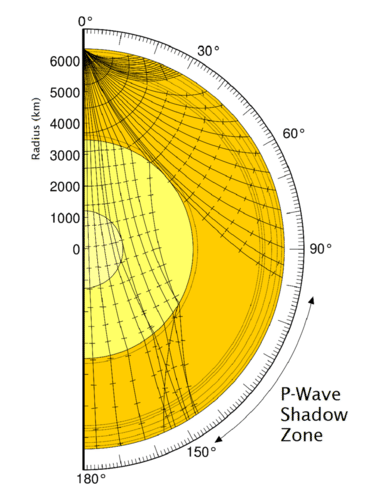
Figure 2. How P-waves travel through Earth’s interior.
S-waves (secondary waves) are about half as fast as P-waves, traveling at about 3.5 km (2 miles) per second, and arrive second at seismographs.
S-waves move in an up and down motion perpendicular to the direction of wave travel. This is called “shear wave”. This produces a change in shape for the Earth materials they move through.
Only solids resist a change in shape (they have very high shear strength), so S-waves are only able to propagate through solids. S-waves cannot travel through liquid because liquids do not have any shear strength.
See more detailed explanation here: https://www.khanacademy.org/science/cosmology-and-astronomy/earth-history-topic/seismic-waves-tutorial/v/why-s-waves-only-travel-in-solids
Where seismic waves speed up or slow down, they refract, changing the direction in which they are traveling. Where seismic waves encounter an abrupt boundary between two very different layers, some of the seismic wave energy is reflected, bouncing back at the same angle it struck. The reflections and refractions of seismic waves allow the layers and boundaries within the earth to be located and studied.
By tracking seismic waves, scientists have learned what makes up the planet’s interior (figure 2).
- P-waves slow down at the mantle core boundary, so we know the outer core is less rigid than the mantle.
- S-waves disappear at the mantle core boundary, so the outer core is liquid.
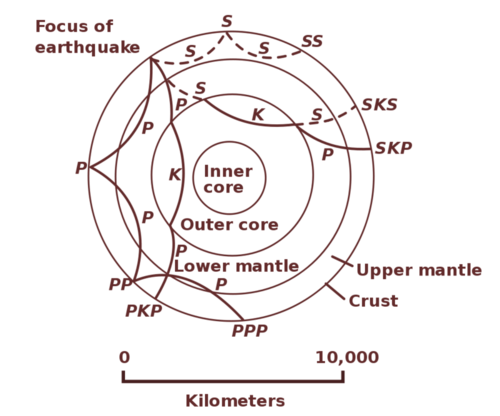
Here are some examples of what we have been able to distinguish in the earth’s interior from the study of seismic waves and how they travel through the layers of the earth:
- The thickness of the crust: oceanic crust: only about 3-5 miles; continental crust: about 25 miles.This is a measure of the thickness of the crust based on the abrupt increase in speed of seismic waves that occurs when they enter the mantle. The boundary between the crust and mantle, as inferred from the change in the speed of P- and S-waves, is called the Mohorovicic discontinuity, named after the Croatian seismologist Mohorovicic who first discerned it; usually it is referred to simply as the Moho. It is mainly from seismic waves that we know how thin oceanic crust is and how thick continental crust is.
- The thickness of the lithosphere. “Oceanic lithosphere is typically about 50–140 km thick (but beneath the mid-ocean ridges is no thicker than the crust), while continental lithosphere has a range in thickness from about 40 km to perhaps 280 km; the upper ~30 to ~50 km of typical continental lithosphere is crust.” (source: https://en.wikipedia.org/wiki/Lithosphere#targetText=Oceanic%20lithosphere%20is%20typically%20about,typical%20continental%20lithosphere%20is%20crust.). Where seismic waves pass down from the lithosphere into the asthenosphere, they slow down. This is because of the lower rigidity and compressibility of the rocks in the layer below the lithosphere. The zone below the lithosphere where seismic waves travel more slowly is called the low velocity zone. The low velocity zone is probably coincident with the asthenosphere.
- The boundary between the upper and lower mesosphere (upper and lower mantle) shows up as an increase in seismic wave speed at a depth of 660 km.
- The boundary between the mantle and the core. This is marked by S-waves coming to an abrupt stop, presumably because the outer core is liquid, and a sudden large reduction in the speed of P-waves, as they enter the liquid core where there is no rigidity to contribute to P-wave speed.
- The inner core: thickness is 1200 km (746 miles). This was first recognized by refraction of P-waves passing through this part of the core, due to an abrupt increase in their speed, which was not shown by P-waves traveling through only the outer part of the core.
Gravity
Isaac Newton was the first to calculate the total mass of the earth (5.972 × 1024 kg). This gives us an important constraint on what the earth is made of, because, by dividing the mass of the earth by the volume of the earth (an approximate value is 1.08 quadrillion cubic kilometers (259 trillion cubic miles), we know the average density of the earth (5.52 g/cm3). Whatever the earth is made of, it must add up to the correct amount of mass.
Gravity measurements, and the earth’s mass, tell us that the interior of the earth must be denser than the crust, because the average density of earth is much higher than the density of the crust.
Because different parts of the crust, mantle, and core have different thicknesses and densities, the strength of gravity over particular points on earth varies slightly. These variations from the average strength of earth’s gravity are called gravity anomalies. Mapping and analyzing gravity anomalies, in some cases by using satellites, and also be measuring the effect of gravity anomalies on the surface shape of the ocean, has given us much insight into subduction zones, mid-ocean spreading ridges, and mountain ranges, including constraints on the depths of their roots.
Moment of Inertia
The earth’s gravity tells us how much total mass the earth has, but does not tell us how the mass is distributed within the earth. A property known as moment of inertia, which is the resistance (inertia) of an object to changes in its spin (rotation), is determined by exactly how matter is distributed in a spinning object, from its core to its surface. The earth’s moment of inertia is measured by its effect on other objects with which it interacts gravitationally, including the Moon, and satellites.
Knowing the earth’s moment of inertia provides a way of checking and refining our understanding of the mass and density of each of the earth’s internal layers.
Meteorites
Studies of meteorites, which are pieces of asteroids that have landed on earth, along with astronomical studies of what the Sun, the other planets, and orbiting asteroids are made of, give us a model for the general chemical composition of objects in the inner solar system, which are made mainly of elements that form rocks and metals, as opposed to the outer planets such as Jupiter, which are made mostly of light, gas-forming elements. The general compositional model of the rocky and metallic part of the solar system has much higher percentages of iron, nickel, and magnesium than is found in the earth’s crust.
If the earth’s mantle is made of ultramafic rock, as is found in actual samples of the upper mantle in xenoliths and ophiolites, that would account for part of the missing iron, nickel, and magnesium. But much more iron and nickel would still be missing. If the core is made mostly of iron, and abundant nickel as well, it would give the earth an overall composition similar to the composition of other objects in the inner solar system, and similar to the proportions of rock and metal-forming elements measured in the Sun.
A mantle with an ultramafic composition, and a core made mostly of iron plus nickel, would make earth’s composition match the composition of the rest of the solar system, and give those layers the right densities to account for the earth’s moment of inertia and total mass.
Experiments
Geology, like other sciences, is based on experiment along with observation and theory. earth scientists and physicists have developed experimental methods to study how materials behave at the pressures and temperatures of the earth’s interior, including core temperatures and pressures. They can measure such properties as the density, the state of matter (liquid or solid), the rigidity, the compressibility, and the speed at which seismic waves pass through these materials at high pressures and temperatures. These studies allow further refinement of our knowledge of what the interior of the earth is made of and how it behaves. These experiments support the theory that the mantle is ultramafic and the core is mostly iron and nickel, because they show that materials with those compositions have the same density and seismic wave speeds as have been observed in the earth.
